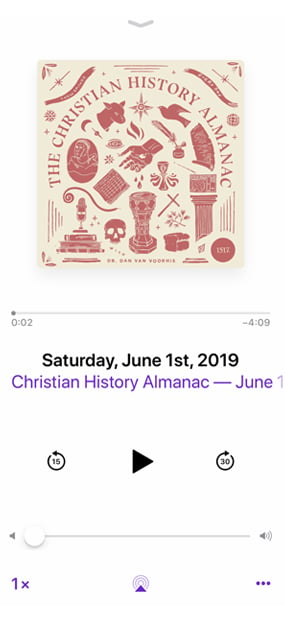Wednesday, May 28, 2025
Today on the Christian History Almanac, we remember an important Medieval Archbishop and the making of “Canterbury” as we know it.
It is the 28th of May 2025. Welcome to the Christian History Almanac, brought to you by 1517 at 1517.org; I’m Dan van Voorhis.
What comes to mind when you hear the word “Canterbury”? Perhaps the Archbishop (you might expect that on a church history podcast). Maybe the “other” St. Augustine- the one from Rome, sent to England, who served as an Archbishop there. Maybe you are reminded of the famous Archbishop of Canterbury: Thomas Beckett, who was famously murdered in the Cathedral there, making it a destination for pilgrims, which led to the industry of inns and public houses there that would be the background for Geoffrey Chaucer’s The Canterbury Tales.
How did this location in Kent become so central to English and church history? The answer, like so many questions in English history take us back to 1066 and the Norman Invasion, William the Conqueror and his trusted theological advisor, Lanfranc who was born in 1005 in Lombardy and died on this, the 28th of May in 1089 in Canterbury having established it as the center of the English church.
Lanfranc was trained in the law and the liberal arts but gave up a life as a scholar to enter the Benedictine Monastery at Bec in Normandy. He would eventually start a school there that would be, among other things, the place where the future Anselm of Canterbury would be taught.
Lanfranc’s reputation as a monk, a scholar, and a teacher made his voice especially important, and he came to the attention of Pope Leo when Lanfranc supported him in condemning the marriage of William of Normandy to Matilda of Flanders. And so he was considered a proponent of Papal authority and a favorite in Rome.
While he opposed the wedding on the grounds of the Papal injunction, he and William would reconcile, and William saw his relationship with Rome as advantageous. So, William makes Lanfranc the abbot at St. Stephen's in Normandy.
Things get kicked into high gear when King Edward the Confessor died in January of 1066. Harold Godwinson would take the English throne, but William believed it was rightly his. Rather than storm the island, he sought international support- and most importantly, support from the Pope. Because of his alliance with Lanfranc, who had been a vocal supporter of the Papacy, William was able to get the support that would lead to his invasion of England and the Norman rule that began with him.
Because of Lanfranc’s support, William gave him the archbishopric at Canterbury after deposing the last Anglo-Saxon archbishop. Lanfranc would hold the Council of Winchester (or rather, a few councils in 1070 through 1076) that would forever change the shape of the English church. A few things were determined, from the curious to the groundbreaking. First, communion had to be wine mixed with water- they had been using beer, and that was forbidden. Secondly, the chalice can not be made of wax or wood (I’d never heard of a wax chalice!). But more importantly, Lanfranc took the command from Pope Gregory that forbade all clergy from marrying. Mandated Clerical celibacy in the Roman church begins here. But with his recognition of the Papal injunction, he was able to then push for independence for the English church under William.
Lanfranc saw the triple threat of the ecclesial rulers, the secular rulers and the crown. He would help establish a two tiered court system- one for church matters and another for the affairs of the state and crown [in just under 500 years this will cause trouble with Henry VIII and the Kings Divorce- which court should decide?]. Furthermore, in the debate between York and Canterbury the Cathedral and archbishop of Canterbury would receive its status as the primate of all England.
Lanfranc would outlive William and was key in helping the all-important succession of the next Norman- William II, aka Rufus, aka “the Red” as king. Lanfranc would die on this, the 28th of May in 1089 in Canterbury- forever famous and central to the English church. Likely born in 1005 he was around 84 years old.
The Last word for today comes from the daily lectionary and Luke 2- Simeon’s story:
25 Now there was a man in Jerusalem called Simeon, who was righteous and devout. He was waiting for the consolation of Israel, and the Holy Spirit was on him. 26 It had been revealed to him by the Holy Spirit that he would not die before he had seen the Lord’s Messiah. 27 Moved by the Spirit, he went into the temple courts. When the parents brought in the child Jesus to do for him what the custom of the Law required, 28 Simeon took him in his arms and praised God, saying:
29 “Sovereign Lord, as you have promised,
you may now dismiss your servant in peace.
30 For my eyes have seen your salvation,
31 which you have prepared in the sight of all nations:
32 a light for revelation to the Gentiles,
and the glory of your people Israel.”
This has been the Christian History Almanac for the 28th of May 2025, brought to you by 1517 at 1517.org.
The show is produced by a man who had not yet considered beer in a wax cup as an early medieval communion option… he is Christopher Gillespie.
The show is written and read by a man, who, along with you, perhaps am now singing the nunc dimitis from Divine Service I… I’m Dan van Voorhis.
You can catch us here every day- and remember that the rumors of grace, forgiveness, and the redemption of all things are true…. Everything is going to be ok.

Subscribe to the Christian History Almanac
Subscribe (it’s free!) in your favorite podcast app.